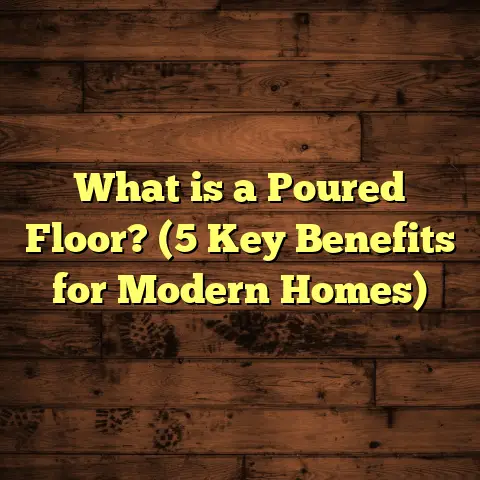What is Waxed Wood Floors? (5 Benefits You Didn’t Know!)
I’ve always had a soft spot for wood floors. They bring warmth, character, and a sense of timelessness to any home. But if you’ve ever lived with wood floors for a while, you know the struggle: scratches, dullness, moisture damage, and that never-ending quest to keep them looking fresh. You want your floors to look amazing but also last a long time without constant hassle.
That’s why I want to talk about something many people overlook — waxed wood floors. It’s an old-school finishing method with some hidden benefits that can transform how you experience your floors every day. Wax isn’t just about shine; it’s about protecting your investment while keeping the natural beauty of wood alive.
If you’re wondering, “What exactly are waxed wood floors?” or if you’ve used other finishes but want to try something different, stick with me. I’ll walk you through what waxed floors really are, how they compare to other finishes, and five surprising benefits I’ve discovered through years of working with floors and chatting with homeowners.
What is Waxed Wood Floors?
Waxed wood floors simply mean that the wood surface is finished and protected by a layer of wax instead of other common finishes like polyurethane or varnish. Wax is applied on the top surface of the wood to create a protective barrier that nourishes and preserves the wood underneath.
Unlike polyurethane, which forms a hard film that seals the wood completely, wax penetrates into the wood and fills its tiny pores and cracks. This creates a flexible, breathable layer that allows the wood to expand and contract naturally with changes in humidity and temperature.
Wax finishes often come from natural sources such as:
- Beeswax: A classic choice that’s natural and non-toxic.
- Carnauba wax: Derived from the leaves of a Brazilian palm tree, it’s harder and gives a higher gloss.
- Synthetic waxes: Sometimes blended with natural waxes for enhanced durability.
How Is Wax Applied?
Applying wax is part art, part science. You can’t just slap it on like paint. Typically, wax is applied with:
- Soft cloths or rags
- Floor buffers with soft pads
- Brushes (less common for floors)
After applying a thin coat of wax, it needs to be buffed to a smooth finish. Buffing creates the desirable sheen and ensures even coverage. Multiple coats can be applied depending on how glossy or matte you want your floors.
Why Wax Instead of Polyurethane or Varnish?
Polyurethane is by far the most popular floor finish today because it’s very durable and low-maintenance. But it has downsides: it’s plastic-like, can crack over time, and sometimes looks artificial.
Wax offers a more natural look and feel. It enhances the wood’s grain and color without hiding its texture. Plus, because it’s flexible rather than rigid, it’s less prone to cracking when the wood moves.
In my experience, waxed floors feel warmer underfoot—almost like the wood has more life. If you’ve ever walked barefoot on a waxed floor versus a polyurethane one, you know exactly what I mean.
Comparing Waxed Wood Floors to Other Finishes: What Works Best?
Over my 15 years in flooring, I’ve installed thousands of square feet using every major finish out there—wax, polyurethane, oil-based varnishes, and oils. Each has its place and purpose depending on your home’s style, use, and your willingness to maintain.
Here’s how waxed floors compare across key factors:
| Finish Type | Durability | Appearance | Maintenance | Repairability | Cost |
|---|---|---|---|---|---|
| Wax | Moderate | Warm glow, natural grain | Reapply every 6-12 months | Spot repairs easy | Moderate |
| Polyurethane | High | Glossy or matte | Low | Difficult patching | Moderate |
| Varnish | High | Glossy | Low | Moderate | Moderate |
| Oil Finish | Moderate | Matte & natural | Periodic oiling | Moderate | Moderate |
Durability
Polyurethane reigns supreme here for high-traffic areas like kitchens or hallways. It stands up well to spills and scratches. Wax doesn’t provide that same level of hard protection but excels in moderate-use rooms like living rooms or bedrooms.
I once had a client try waxing their entryway floor—big mistake because winter salt wore the wax off quickly. But they loved waxing their dining room floor where traffic was lighter.
Appearance
Wax is where things get interesting. Other finishes can look “plastic” or overly shiny in artificial light. Wax brings out depth in wood grain and produces a soft glow that makes the floor feel alive.
A personal story: Early in my career I refinished an old farmhouse floor with wax. After buffing, the honey tones practically glowed in the afternoon sun. The homeowners said it felt like walking on history—something poly could never replicate.
Maintenance
Wax requires more regular upkeep than poly or varnish. You need to reapply every 6-12 months depending on use. But this isn’t necessarily bad—it lets you refresh the floor’s look regularly without heavy sanding.
For people who enjoy caring for their home (or want to learn), waxing can be rewarding rather than burdensome.
Repairability
Here’s a big advantage of wax: spot repairs are simple. Scratches can be buffed out and rewaxed locally without refinishing the entire floor.
I helped a client who dragged furniture across their waxed floor accidentally. Instead of sanding down the whole room, we cleaned and reapplied wax just in that area—done in under an hour.
Cost
Costs vary by region but waxing tends to be moderately priced—usually cheaper than polyurethane because it doesn’t require expensive equipment or toxic chemicals. However, factor in ongoing maintenance costs too.
The Science Behind Waxed Wood Floors: What Research Shows
I’ve always been curious about what studies say regarding wax finishes versus others. Here are some key insights from industry research:
Moisture Balance & Wood Longevity
Wood expands and contracts with changes in humidity—a big reason floors crack or warp over time.
A study from the University of Minnesota found that wax finishes help wood maintain better moisture balance compared to polyurethane coatings. The flexible wax layer allows slow moisture exchange while protecting against rapid water absorption.
In practical terms? Waxed floors may suffer fewer cracks in humid climates or homes with fluctuating temperatures.
Indoor Air Quality
Many synthetic finishes release volatile organic compounds (VOCs) during application and curing, which can affect indoor air quality negatively.
Research from the University of Tennessee monitored VOC emissions during floor finishing:
- Polyurethane finishes emitted 400-500 µg/m³ VOCs in curing phase.
- Natural wax finishes emitted less than 50 µg/m³.
- VOC levels normalized faster in rooms with wax finishes.
If you have asthma or chemical sensitivities at home, waxing is definitely worth considering for healthier air.
Slip Resistance
According to an Australian safety study on floor coatings:
- High-gloss polyurethane surfaces showed lower slip resistance when wet.
- Waxed floors maintained moderate slip resistance due to softer texture.
- This makes wax preferable in homes with elderly residents or children where falls are a concern.
Five Benefits of Waxed Wood Floors You Didn’t Know
Now let me share five benefits I’ve discovered over years of flooring work—benefits that might surprise you if you think waxing is just about shine.
1. Enhanced Natural Beauty That Ages Gracefully
Wax doesn’t just protect wood—it enhances its grain and tones over time. As dirt settles into pores or light hits at different angles, wax lets your floor develop “character marks” that tell your home’s story.
I witnessed this firsthand restoring 100-year-old oak floors that had been neglected for decades. After waxing, subtle variations popped out beautifully instead of being masked by plastic-like coatings.
2. Healthier Indoor Environment With Less Chemical Exposure
Because natural waxes contain no harsh solvents or VOCs common in some finish products, they’re much safer for indoor air quality.
This matters especially for families with young kids or pets who spend lots of time on the floor. I’ve had clients switch to waxing after problems with chemical sensitivities worsened post-polyurethane installation.
3. Softer Surface That’s Easier on Feet and Furniture
Waxed floors feel warmer and softer underfoot compared to hard coatings that can feel cold or slippery.
This also means less wear on furniture legs or pet claws—wax absorbs minor impacts better so dents don’t set permanently as easily.
A client once told me their dog loved running on their waxed living room floors because they weren’t slippery like tile or finished hardwood elsewhere.
4. Simple DIY Repairs & Maintenance Saves Money
Reapplying wax yourself once or twice a year costs far less than hiring professionals for sanding and refinishing polyurethane floors every 7-10 years.
Plus spot repairs are straightforward—clean area well and apply fresh wax with a soft cloth. No dust, no noise, no downtime needed.
I always recommend homeowners try waxing one room first before committing house-wide to see if they enjoy the maintenance routine.
5. Flexible Sheen Options for Personalized Style
With waxing, you control how shiny your floors get just by adjusting how much you apply or how much you buff.
Want a low-key matte look? One thin coat works great. Craving that mirror-like glow? Multiple layers buffed well deliver it effortlessly.
I love helping clients experiment with this during installations because it makes each home unique.
A Deep Dive Into My Personal Journey With Waxed Floors
When I first started installing floors professionally over 15 years ago, polyurethane was king—durable, fast-drying, easy to clean up. But I kept hearing whispers from old-timers about “waxed floors” being more natural and beautiful despite extra maintenance.
Curious, I took on a restoration project for an old craftsman bungalow where all finishes had worn away through decades of wear. After stripping down to bare pine boards, I painstakingly applied layers of beeswax over weeks.
The transformation blew me away—the warmth, depth of color, subtle sheen were unlike anything I’d seen with poly-coated floors before. The owners loved how “alive” the floor felt underfoot—soft but durable enough for everyday life.
Since then I’ve recommended waxing for specific projects:
- Historic homes where authenticity matters most
- Bedrooms and living spaces with moderate traffic
- Clients sensitive to chemicals wanting natural finishes
- Homeowners who enjoy regular maintenance as part of caring for their space
It’s never been about one-size-fits-all but finding what fits each home’s personality best.
Practical Tips For Waxed Floor Care From My Toolbox
If you’re thinking about waxing your floors or already have them, here are some practical tips from my years on job sites:
Cleaning
- Use a dry mop or vacuum regularly to remove dirt before it grinds into finish.
- Avoid wet mopping; water breaks down wax layers quickly.
- For sticky spots use slightly damp cloth but dry immediately afterward.
Reapplication Schedule
- Every 6-12 months depending on foot traffic intensity.
- High traffic areas may need waxing twice yearly; low traffic once per year works well.
- Reapply thin coats rather than thick layers for best results.
Buffing
- Buff after each wax application using soft cloths or mechanical buffers.
- Buffing evens out sheen levels and removes excess wax buildup.
- Avoid aggressive scrubbing which may thin finish unevenly.
Spot Repairs
- Clean damaged spots thoroughly before applying fresh wax.
- Use matching wax types/colors for best blend.
- Buff spots gently after application for smooth transition.
Choosing Your Wax
- Opt for natural beeswax or carnauba-based products for best quality.
- Avoid synthetic blends with harsh chemicals.
- Test small inconspicuous areas first if unsure about compatibility with your wood species.
When Not to Choose Waxed Floors
Wax isn’t perfect for every situation. Here are some cases where I usually don’t recommend it:
- Kitchens and Bathrooms: High moisture areas where water spills may degrade wax quickly.
- Heavy Commercial Use: Spaces like offices or retail stores need ultra-durable poly finishes.
- Busy Households Unwilling To Maintain: If you want zero upkeep beyond cleaning, poly might be better.
- Extremely High Traffic Entryways: Salt or grit can wear down wax fast causing patchiness.
That said, even challenging areas can sometimes benefit from hybrid systems combining oil-wax blends if properly maintained by pros familiar with those techniques.
Cost Breakdown: How Much Will Waxing Your Floors Set You Back?
Cost varies by location and project size but here are rough estimates based on my experience:
| Service | Price Range (USD) |
|---|---|
| Professional Stripping & Waxing (per sq ft) | $3 – $6 |
| DIY Wax Kit (per gallon) | $30 – $70 |
| Buffing Equipment Rental | $40 – $80 per day |
| Reapplication (DIY) | $50 – $100 per room |
Professional application costs more upfront but ensures even coverage and quality finish—great for first-timers or large spaces. DIY waxing can save money long-term but requires some effort learning technique.
Factor ongoing maintenance into your budget! Rewaxes twice yearly add up but prevent costly floor repairs later on.
Real Case Study: Reviving A Century-Old Oak Floor With Wax
A few years ago I worked on restoring an old oak floor in a historic downtown home built in 1910. The previous polyurethane finish had cracked badly causing moisture damage underneath.
We stripped down all surface coatings completely then applied multiple coats of natural beeswax over several days. The results were stunning: deep amber hues returned along with rich texture revealing the wood’s age gracefully instead of hiding it under plastic film.
The homeowner told me their friends immediately noticed how cozy and inviting their space felt after waxing compared to before when floor looked sterile despite being “newly finished.”
This project convinced me more than ever that waxing isn’t outdated—it’s a rediscovered treasure for anyone wanting authentic wood character combined with practical protection.
FAQs About Waxed Wood Floors
Q: How often do I need to reapply wax?
A: Typically every 6 to 12 months depending on traffic levels and environment humidity.
Q: Can I apply wax over an existing finish?
A: Generally no. You need bare wood or stripped floors for best adhesion unless product instructions say otherwise.
Q: Is waxing safe around pets and kids?
A: Yes! Natural waxes are non-toxic and better for sensitive indoor air quality than chemical finishes.
Q: Will waxing darken my wood?
A: Slightly yes—it enhances warm tones but shouldn’t drastically change color unless multiple coats build up heavily.
Q: Can I use any type of wax?
A: Use floor-specific natural waxes designed for hardwood—not furniture paste wax or car polish variants which can be too soft or harmful long-term.
Waxed wood floors aren’t just another option; they’re a lifestyle choice for people who appreciate natural beauty combined with thoughtful care. Whether you want soft warmth underfoot, easier spot repairs, healthier home air quality, or just love that rich glow only wax delivers—you might find this finish fits your home better than you expected.
If you’re thinking about waxing your floors or want help deciding which finish suits your space best, drop me a line! I’m happy to share detailed advice tailored to your needs based on years of hands-on experience. Your wood floors deserve care that keeps them looking great—and feeling alive—for generations to come.





